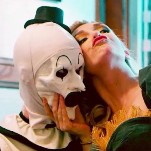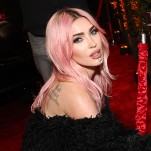How Artist Erica Magrey Turned '90s YM and Seventeen into Living Art
EntertainmentFor Erica Magrey, a Brooklyn-based multimedia artist, teen-girl magazines from the ’80s and ’90s were bibles, as they were for so many of us. So in her latest online art project, Vistas, Magrey explores “various gestures associated with femininity, sexuality, and positions of power” she learned from back issues of YM and Seventeen by dressing up herself and several women she knows in clothes from that era, on screens accessorized with symbols of that femininity and power—make-up, pens, cutting boards, clocks—in pastels so pitch-perfect it’s almost astonishing for any of us who grew up reading those rags.
With these representations—videos of six women total, and ambient soundtracks to each—she says, “Each woman portrays an exaggerated version of herself, expressing both a desire for freedom from social expectations as well as the internalization of various behaviors, styles, and attitudes prescribed for her throughout her life.” Or, as I interpret it, a chance to re-enact and maybe even exorcise some of the bullshit we learned reading teen mags, while also celebrating the complex dreams and aspirations they instilled in us. And: a deep nostalgia for product like Dippity Do and Studio Line from L’Oreal. Sculpt your hair… any way you like it! God, the freedom we were promised…
Jezebel spoke with Magrey about the importance of YM and Seventeen back issues, what ’80s and ’90s visual cues mean for women’s identities in the 2010s and, of course, Niki and Krissy Taylor.
What was your impetus for doing this project?
I try to use my work to engage with something that I’m afraid of, and that often involves looking at how I’m representing myself—what I’m putting out there, how it is perceived, and how I can shape that. In this case, I’ve spent the last nine months reflecting on who I am at my core, after peeling back layers of influence and compromise that accompanied a romantic relationship that began when I was 16 and spanned over half of my life. In doing that, I found myself re-entering a mental space akin to one I occupied as a teenager—pumping myself up, finding immense solace and joy in friends, considering my assets. Despite the insecurities of my actual teenage experience, time-traveling back revealed a more self-assured and optimistic spirit. At the same time, the outpouring of support from friends and family during this time was extremely moving, and I felt a huge surge of love. Long story short—I got my groove back. I’d been exploring these issues while I was married too, but at times, it felt like there was a conflict there—not that I didn’t “own” my own self-image, but that it might have been subject to a degree of scrutiny that I was uncomfortable with. So ultimately for me this is about expressing authority over my own image as a woman, and as sexy, awesome, powerful, funny, and as strange as that image might be, truly owning it.
Of course the influences on the way we define ourselves are many and varied, and we absorb ideas about how to act, pose, dress, etc, from the people and images in our lives. My vision of myself as a woman when I was young was shaped by my mother, a business analyst who rocked corporate attire; my father, who loved divas like Grace Jones and Sinead O’Connor; my “cool aunt” who had wild hair and was into styles more under the radar; and many images from magazines, movies, and TV. When my dad recently discovered a huge bin of teen magazines we thought he’d thrown out, I was blown away by how the images inside were intimately familiar, like I had pored over them hundreds of times. So I think for each of us, there is this interesting blend of influences that we pick and choose from to produce this hybrid self. And I’m interested in how other women navigate that. In concocting the exaggerated versions of ourselves depicted here, it’s interesting how we resort to familiar depictions and stereotypes and then merge or clash with them.
I’m also curious about how women work in tandem with or in opposition to other women and how those relationships are depicted, and in the group shoot—in the “Rap Room”—we have a lot of fun exploring this.
Pre-Sassy, I remember teen fashion mags being controversial in those times, from a feminist perspective, this idea that they were indoctrinating us into the patriarchy and turning our minds to mush. Are you making any commentary on that? Is your perspective that they were actually empowering us in the end?
I don’t think they were empowering, no, but certainly having an awareness of the influence they exerted is empowering. There were many cases where they provided mush-mind material, like fluff articles about how to kiss and embarrassing stories about tampons flying out of purses, and they did often perpetuate ideas about softness and femininity and also ideas about female relationships to love and sex that I still, 20 years later, find a little hard to shake.
-

-

-

-

-

-

-

-

-

-

-

-

-

-

-

-

-

-

-

-

-

-

-

-

-

-

-

-

-

-

-

-

-

-

-

-

-

-

-

-








































